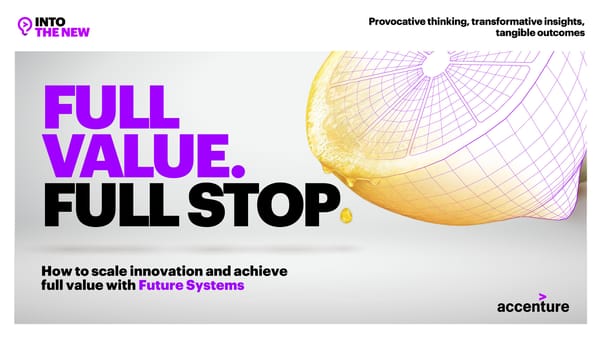Full Value. Full Stop
Interactive Report | How to scale innovation and achieve full value with Future Systems | 30 pages
Provocative thinking, transformative insights, tangible outcomes FULL VALUE. FULL STOP How to scale innovation and achieve full value with Future Systems

About the authors Bhaskar Ghosh Adam Burden James Wilson Dr. Bhaskar Ghosh is group chief executive—Accenture Adam Burden is Accenture’s Chief Software Engineer. He H. James Wilson is managing director of IT and Business Technology Services. In this role, he directs strategy and leads Accenture’s Intelligent Software Engineering Services Research at Accenture Research, where he leads global investments for Accenture Technology Services, and leads organization, which includes 35,000+ software and system research programs on the impact of technology on work. platforms, products, global technology delivery and engineers. In this role, he oversees strategy and operations, Wilson is co-author of the best-selling book Human + intelligent cloud and infrastructure services. His focus is to client services in the areas of technical architecture and Machine: Reimagining Work in the Age of AI (Harvard enable enterprises to embrace digital disruption, drive custom systems engineering and the incubation of next- Business Review Press). He is author or contributing author growth through innovation and reinvent their application generation capabilities related to blockchain, augmented of eight books on the impact of technology on work and portfolio. Ghosh and his organization help enterprises reality and other disruptive technologies. society, including most recently, AI, Analytics, & The New transform their business through the adoption of New IT, Machine Age (HBR Press 2019) and How to Go Digital (MIT spanning strategy, technologies, architectures, platforms, During his 27-year career at Accenture, Burden has been Press 2019). methods, organization and operating models. part of numerous pioneering engagements, including serving as lead architect for the world’s largest wholesale Wilson wrote “The Jobs Artificial Intelligence Will Create,” Under Ghosh’s leadership, Accenture Technology Services electricity market. He is a certified Solution Architect and MIT Sloan Management Review’s #1 Most-Read article of has rapidly rotated to the New. More than 180,000 Master Technical Architect with specializations in legacy the year, and is a longtime contributor to The Wall Street Accenture Technology people have been trained around the modernization, cloud native applications, DevOps, Journal and HBR. His latest HBR article is “The Future of AI world in New IT, including automation, Agile development automation engineering and enterprise architecture. He Will Be About Less Data, Not More.” and intelligent platforms. Ghosh has been awarded patents has also held both client and technical account in multiple areas, including IT automation. He is a member of leadership positions. the Accenture Global Management Committee. Twitter: @DrBhaskarGhosh Twitter: @adampburden Twitter: @hjameswilson Future Systems 2
EXECUTIVE SUMMMARY Strategic use of Future Systems can give your company a clear advantage 80% of success is just showing up, right? Think again. competitors. Simply showing up—adopting the Laggards often adopt technologies—does not guarantee success. technologies as individual Today’s C-suite is making significant investments in new technologies. Yet they are not necessarily achieving full To crack the code on scaling innovation and closing the point solutions without a value. They’re deploying technologies in pockets, or achievement gap, we collected data from companies strategy for enabling systems silos, of their organizations, without a strategy for scaling across three categories: 1) the adoption of key the innovation from these technologies across the technologies, 2) the penetration of technologies adopted that can achieve enterprise- enterprise. Unable to scale their innovation, they’re not and 3) organization and culture. We then scored them on wide, game-changing realizing the full benefits of their technology these factors, calling companies in the top 10% investments. “Leaders,” and those in the bottom 25%, “Laggards.” innovation. While they This is creating what we call the innovation achievement Just how successful are the Leaders compared to the might have pockets of gap—the difference between potential and realized value Laggards? Leaders are seeing more than 2X the brilliance, they can’t from technology investments. For executives who are revenue growth of Laggards. maximize the value achieved. under relentless pressure to change and grow, it’s frustrating to make these investments and still fall behind Future Systems 3
EXECUTIVE SUMMARY Even worse, the lost potential is snowballing: Leaders concentrate not only on technology adoption, but also on its penetration across the enterprise, to In 2018, Laggards had 15% in foregone annual revenue. enable innovation transfer and a nimbler response to If they don’t change, they could miss out on a market conditions. For example, they ensure that cloud staggering 46% of their annual revenue in 2023. And services permeate across the enterprise and treat it’s not just those with legacy systems that are data—across organization silos—as a corporate asset. struggling; not all digital native companies are realizing the full value from technology adoption, either. Finally, Leaders carefully consider how new technologies will interact with the people and processes already in What’s so special about those in the top 10%? Their place in their organization, and they nurture talent in mindset, for starters: Crucially, Leaders think in terms of creative ways. systems and not individual technologies. With a clear vision, they are evolving to what we call Future Systems, or boundaryless, adaptable and radically human While some leaders are born, enterprise systems capable of scaling innovations others are made: Everyone repeatedly and making organizations strategically agile. can emulate the mindset and Their methods are different, too: Leaders adopt earlier, methods of the top 10% to get reinvest more frequently and acquire technology in a more deliberate manner. For instance, they install data the value they expect from streaming platforms, or event hubs, that can process millions of actions in real time before they adopt AI. their significant investments Leaders have directed a greater percentage of their IT in technology. budget toward innovation over the past five years and expect to accelerate investment in innovation faster than Laggards over the next five. Future Systems 4
CLICK THE FUTURE INTO PLACE Through our in-depth analysis of the data we collected, we’ve been able to pinpoint the many ways in which leaders stand out in their approach to enterprise technology and how they use it to innovate at scale and drive long-term financial performance. FFuuttuurere S Syysstetemmss 55
THE INNOVATION ACHIEVEMENT GAP Imagine an electrician who installs a new gadget for a Why is it that technology is But it’s not the case that digital native companies are customer, such as a video doorbell. If he doesn’t figure everywhere, but value is not? closing their innovation achievement gaps, while legacy out a way to integrate it with other devices in the house, companies aren’t. While they might have started in the like the security system or the family’s cell phones, it Value is difficult to capture in part because of the cloud, some digital native companies haven’t adapted their won’t be possible to achieve the benefits of a truly enormous challenge of innovating with legacy systems. systems at the pace of technological change. In every kind connected home. The conventional IT “stack”—spanning software of company, growth depends on a systematic and applications, data, hardware, telecommunications, sequential adoption strategy in line with Future Systems— A similar scenario plays out on a much grander scale facilities and data centers—wasn’t built for today’s enterprise systems capable of scaling innovations across global organizations. CIOs, CDOs and CEOs cloud-oriented world of analytics, sensors, mobile repeatedly and giving organizations the strategic agility understand technology’s significance to their company’s computing, artificial intelligence, the Internet of Things they need to stay ahead of their competitors. strategy and growth. So, in every industry, they’re (IoT), and billions and billions of devices. Nor was it adopting technology that spawns new capabilities. But designed to adapt to the world of tomorrow, whatever despite these substantial investments, many still struggle that might be. to transfer innovations across the enterprise and realize their potential. It’s causing an innovation achievement gap—the difference between potential and realized value from technology investments. Future Systems 6
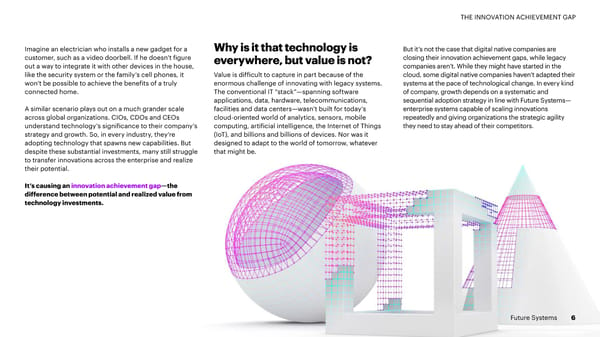
This is a modal window.
WORK A staggering difference THE SYSTEMS in revenue growth Leading companies are achieving 10 8 significantly more value with the help of Future Systems LEADERS How, then, can companies maximize their investment in technology? To crack the code, we 6 9% conducted our largest enterprise systems survey ever, encompassing C-level executives (half in IT and half in business) at more than 8,300 companies across 20 industries and 20 countries. 4 We collected data on companies’ IT systems strategies—specifically, about 1) the adoption of key technologies, 2) the penetration of technologies adopted and 3) organization and culture. LAGGARDS Then we scored them on these dimensions, calling companies in the top 10% Leaders, and those in the bottom 25%, Laggards. By tracking companies’ performance indicators between 2 4% 2015 and 2023 (projected), we can see the relationship between technology adoption and achieved, or expected, value. The difference is staggering: Leaders grow revenue at more than twice the rate of 0 Laggards. (See Figure 1) Figure 1: Leaders—those that are evolving to Future In 2018, Laggards had what amounted to 15% foregone annual revenue. If they don’t Systems—are growing revenue at more than change, they could miss out on as much as 46% of their annual revenue in 2023. double the rate of Laggards. Based on average (See Figure 2) self-reported annual growth rates for 2015-2018. Future Systems 7
WORK THE SYSTEMS Leaders are poised to extend their advantage over the next five years $22 bn Leaders Growth Rate $20 Billion Still stands to be lost $20 bn in the next 5 years $18 bn Gap = 46% $16 bn $3Billi on has already been foregone Laggards Growth Rate Revenue (billions)$14 bn $12 bn $10bn 2015 2016 2017 2018 2019 2020 2021 2022 2023 Figure 2: An illustrative model of the difference between Leaders and Laggards’ revenue growth is projected to widen. Companies failing to evolve to Future Systems could miss out on as much as 46% of their annual revenue by the year 2023. Leaders’ expected growth is represented by the purple line and Laggards the blue line (self-reported). For sake of simplicity, we illustrate the opportunity cost of not evolving to Future Systems using a company with $10 billion in revenue in 2015. Your specific opportunity cost depends on your revenue in 2015. For instance, if your revenue was $5 billion in 2015, you stand to forgo as much as $10 billion between now and 2023. Future Systems 8
THINK LIKE THE TOP 10% Discover what leaders do differently 01 Leaders invest more in innovation. 02 Leaders don’t just adopt technology, they create systems. 03 Leaders scale technology innovation across the enterprise. 04 Leaders understand that Future Systems must be boundaryless, adaptable, radically human. Future Systems 9
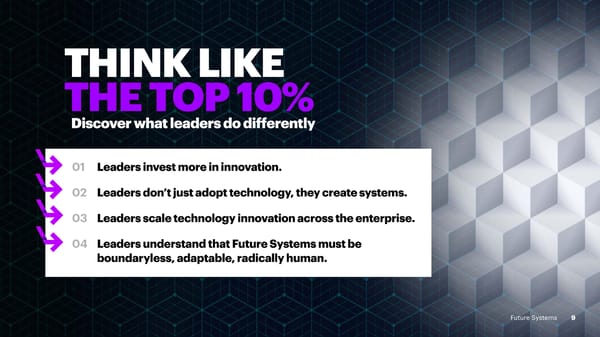
This is a modal window.
THINK LIKE THE TOP 10% Leaders invest more in innovation 2015 - 2019 2019 -2023 1% 100 2% 100 2% 15% 5% 9% 80 80 17% 21% 60 60 93% 97% 40 64% 40 74% 20 20 Increased 0 0 Stayed the same LAGGARDS LEADERSLSLAGGARDSLEADERS Decreased Figure 3: Proportion of budget spent on innovation, now and expected. Leaders spend a much higher proportion of their IT budgets on innovation. And, expect to further increase their spend in the future. Future Systems 10
THINK LIKE THE TOP 10% Leaders have a deliberate stance toward technology adoption and a clear vision for what their companies’ future systems should look like. Leaders have directed a greater percentage of their IT budget toward innovation over the past five years and expect to accelerate investment in innovation faster than Laggards over the next five. (See Figure 3) While technology adoption is pervasive among all the companies surveyed, Leaders show a consistently higher rate than others. (See Figure 7) They tend to adopt new technologies earlier, develop higher levels of expertise, and prioritize and sequence implementations in optimal ways. In doing so, they create systems rather than point technology solutions. For example, Leaders adopt AI, a fundamental general-purpose technology, at a rate of 98%. And even more revealing, before implementing AI, Leaders set up complementary technologies such as data lakes (a system or repository of data stored in its raw format) and cloud services (any service made available to users on demand via a cloud computing provider’s servers). Laggards, on the other hand, have faith in a “fast follower” approach, taking on technology somewhat haphazardly leading to a patchwork across the organization. Only 42% of Laggards have implemented AI, for instance. Often following fads, they put in place technologies as individual point solutions without a vision for how technologies will complement each other, and without a plan for cultivating enterprise systems. As a result, when a potentially game-changing innovation comes along, they cannot effectively scale it. Future Systems 11
THINK LIKE THE TOP 10% For example, a major apparel manufacturer developed a wearable device to help users track their exercise but failed to Leaders believe that humans and generate meaningful insights from the data collected. That machines can bring out the best in each would have required building a machine learning-based analytics platform that could harness the data to provide other and that innovations within the real-time predictive analytics that customers could use. organizations as well as in their Because the company opted not to, sales were limited. It was forced to cease production, and eventually stop offering ecosystem of partners can be scaled. support services on apps for existing customers. It’s one reason they’re motivated to While Laggards don’t move beyond innovating in pockets, build Future Systems that are: Leaders set their sights on innovating at scale. Because of that perspective, they show the highest levels of penetration across 1 the 13 critical business processes our survey covered. In fact, Leaders target 3 times more business processes with technologies they adopt than Laggards. As a result, their 01 Boundaryless systems allow for a seamless flow of product and service innovations from one process to another 02 Adaptable 03 Radically human Future Systems 12
THINK LIKE THE TOP 10% 01 Boundaryless: Boundaryless systems take advantage of blurring boundaries to create new spaces where ideas and partnerships can flourish. 75% Historically, the components of the IT-stack—database, applications, and infrastructure—have been treated as independent entities. These days, rigid divisions are fading. More than 75% of our respondents say that systems are breaking down the boundaries between data, infrastructure and applications, between humans and machines, and even between competing organizations. (See Figure 4) Systems which are boundaryless utilize the cloud, have a uniform say systems are breaking approach to data, security and governance, and have established paths down the boundaries between for exploring unconventional partnerships—giving businesses almost infinite opportunities to improve how they operate. data, infrastructure and applications, between humans and machines, and even between competing organizations. Figure 4 Future Systems 13

THINK LIKE THE TOP 10% 02 Adaptable: Leaders believe decoupling Adaptable systems learn, improve, and scale enables adaptable systems by themselves, eliminating the friction that 100 100 hinders business growth and helping humans make better decisions, much faster. 80 Powered by advances in cloud, data, and intelligent technologies, LEADERS those with adaptable systems aren’t fazed by change. The companies we surveyed understand how self-learning systems enable strategic 60 80% agility: Eighty-three percent want systems that allow them to pivot to new directions. Key markers of adaptable organizations include enterprise-wide use of 40 automation and AI, a continuous data supply chain in the cloud to power AI in the enterprise, and a stable but modular, flexible, LAGGARDS decoupled and constantly evolving architecture. (See Figure 5) 20 40% 0 Figure 5: More than 80% of Leaders agree that decoupling the entire IT stack is a key step toward adaptable systems, compared to less than 40% of the Laggards. Future Systems 14
THINK LIKE THE TOP 10% 03 Radically human: Radically human systems talk, Thanks to technologies such as natural- listen, see and understand just language processing, computer vision, voice like we do, bringing elegant recognition, and machine learning, these systems are becoming less artificial and more simplicity to every human- intelligent, making them easier to interact with 91% and more efficient. machine interaction. A full 80% of our survey respondents believe Leading radically human companies have a systems will interact seamlessly with humans, structured, fail-fast approach to evaluate the and 78% think these systems will embrace the potential of emerging technologies, they apply way humans work. responsible AI frameworks to build human- machine trust and they use human-centric of Leaders are Radically human companies empower people to design as a standard practice. extremely effective break down organizational barriers. Ninety-one percent of Leaders are extremely effective at Companies that can think in terms of systems, at working with cross- working with cross-department teams that as opposed to point-solutions, stand to outpace department teams that combine IT and business to create customer- others in terms of both revenue and margin centric solutions, compared with only 41% of growth. It starts with envisioning their own combine IT and business Laggards. (See Figure 6) version of boundaryless, adaptable and to create customer- radically human future systems. centric solutions. Figure 6 Future Systems 15

THINK LIKE THE TOP 10% Leaders master technology adoption Leaders Big data analytics 100% Distributed logs/event hubs 96% 68% 30% Laggards 98% Streaming/real-time data 59% 99% DevOps automation/CI/CD 29% Cloud SaaS/Software as a service 97% Blockchain 94% 59% 34% Internet of Things (IOT) 99% Robotics 93% 54% 41% Cloud IaaS/Infrastructure as a service 97% Edge/Fog Computing 95% 52% 32% Cloud PaaS/Platform as a service 97% Microservice Architectures 97% 51% 27% Data Lakes (data repository) 98% RPA (Robotic Process Automation) 92% 50% 36% Open Source 98% Extended Reality (AR/VR/MR) 95% 46% 32% Cloud Native Applications (custom) 98% Serverless Computing 94% 41% 31% Top-Down AI (E.g. expert systems, logic and 98% React/Event-driven architectures 97% inference engines) 42% 25% 97% Hybrid Cloud 48% 92% DevSecOps 27% Bottom-Up AI (E.g. deep learning, machine learning) 98% FaaS/Functions as a Service 25% 95% 41% NoSQL databases (key-value, document, graph) 98% Containers, Docker, & Kubernetes 96% 35% 25% 3D Printing 90% 37% Figure 7: Technology Adoption Rates, Leaders and Laggards. Figures here show rates of adoption of specific technologies in aggregate. Leaders also, by and large, adopt these technologies earlier than Laggards. Future Systems 16
ACT LIKE THE TOP 10% There’s method in the mindset Companies have to put their mindset into practice with the right methods, honing 01 Adopt technologies that make the organization fast and flexible. the technology and capabilities that will help them rise above the rest. These 02 Get grounded in cloud computing. behaviors come as second nature to some companies, but others can learn to 03 R ecognize data as being both an asset and a liability. implement them. Here are five key actions Leaders consistently take to close their 04 Manage technology investments well—across the enterprise. innovation achievement gaps: 05 Find creative ways to nurture talent. Future Systems 17
ACT LIKE THE TOP 10% 01 Adopt technologies that make the organization fast and flexible Leaders create architectures Leaders are moving to decoupled data, infrastructure Even digital native companies are faced with the need and processes built for change and applications that enable greater flexibility and a to update monolithic enterprise architectures. When 100 faster-moving IT culture. Eighty-three percent of them one travel industry disruptor first launched their agree that it’s important to decouple data from legacy business just over a decade ago, speed to market was infrastructure, compared with only 37% of Laggards. paramount, so getting the right long-term, scalable architecture in place wasn’t a priority. 80 Laggards are also far behind in the adoption of DevOps, automation and continuous integration/continuous Then the company faced the challenge of scaling its deployment, with a 29% adoption rate compared with 98% platform to meet the demands of a growing customer LEADERS of Leaders. All of these technologies and approaches are base and geographic expansion. As part of a 60 97% designed to help companies eliminate dependencies in their decoupling initiative, it migrated its platform to systems and processes, which in turn makes them more microservices, which allows the company to rapidly agile. Across the world, companies cite architecture flexibility respond to change and add new features as it as one of the biggest barriers to innovating at scale. (See experiences explosive growth. 40 Figure 13) Leaders opt for flexible, uniform and scalable Leaders’ adoption of critical technologies that allow architectures capable of responding to market decoupling outpaces that of Laggards by a massive demands, like seamless customer payments. Laggards, 20 margin: 97% to 30%. These technologies include on the other hand, find it difficult to move away from LAGGARDS microservice architectures (enabled by a suite of tools that rigid IT architectures, which leaves them unable to break applications into simple, discrete services), containers maximize investments in innovation. 30% (a way to package an application so it can be run in isolation from other processes) and Kubernetes (an open-source 0 container-orchestration system for automating application Figure 8: Leaders’ adoption of critical technologies deployment, scaling and management). (See Figure 8) that allow decoupling outpaces that of Laggards by a massive margin. Future Systems 18
ACT LIKE THE TOP 10% 02 Get grounded in cloud computing Leaders adopt sophisticated Cloud computing is essential to Future Systems because it enables cloud services companies to successfully utilize other technologies, including AI 100 and analytics. As such, Leaders treat the cloud as a catalyst for innovation. Ninety-five percent of them have adopted sophisticated cloud services like serverless computing, compared to 30% of Laggards, who tend to see the cloud as a 80 cost-effective “data center.” (See Figure 9) LEADERS Alibaba Group’s financial arm, Ant Financial, for example, is using cloud and AI to offer a range of services in mobile payments, banking, 60 95% insurance and wealth management.2 Cloud services and AI are embedded across multiple processes and product lines—adapting to each as needed. As a result, the company can instantly assess the credit risks of underserved people who may not have bank accounts, 40 and even target them with loan offers. It can also enable customers to snap photos after an automobile accident to file claims with their insurers in just a few seconds.3 Ant has transferred innovations and lessons at scale across the 20 LAGGARDS organization. And it’s gone even further, offering its AI capabilities to 30% external ecosystem partners. Caifu Hao, an AI-powered corporate account on the Ant platform, for instance, has brought tangible 0 4 benefits to 27 fund management companies. The funds have reported a reduction in overall costs by 50%, a ten-fold increase in daily visitors Figure 9: 95% percent of Leaders have adopted sophisticated and a three-fold increase in investments by returning customers.4 cloud services compared to 30% of Laggards. Future Systems 19
ACT LIKE THE TOP 10% 03 Recognize data as being both an asset and a liability Out of the 28 technologies we surveyed companies about, brand reputation and regulatory compliance. Ninety-four respondents ranked “technologies associated with real-time percent of Leaders have a systematic way of managing AI in a data capture and analysis” as the most important to responsible/ethical manner, compared to 49% of Laggards. transforming/improving their business processes. Again, Leaders are ahead of their peers. Bonnier AB, a large media group with more than 180 companies, wanted to achieve full compliance with the Leaders ensure data quality, creating security measures that European Union’s General Data Protection Regulation anticipate threats and building ethically responsible (GDPR)—a tall order, given that each of these companies frameworks for managing data and AI. This establishes a managed its own IT systems.5 90% virtuous cycle of data creation and consumption, because quality is always improving. Against a tight timeline, Bonnier AB implemented an automated solution for GDPR compliance that included They don’t rely on unverified or biased data to make decisions advanced pattern-matching and machine learning techniques and instead take steps such as using AI itself to detect biased to automatically discover personal data across its systems. algorithms. Only 40% of Laggards ensure data quality, but 90% It also brought together the company’s disparate data of Leaders do. And while just 54% of Laggards continue to sources and deployed a machine-led compliance solution of Leaders enrich their data, 90% of Leaders are doing so. (See Figure 10) to help two of its key business units achieve compliance continue to at speed and scale. As a result, 94% of Leaders trust that the data at their disposal enrich their data. is reliable enough to drive business change, compared with Now Bonnier can scan personal data throughout the data 64% of Laggards. Misuse of employee or customer data can lifecycle. It is also able to use powerful visualization of result in a very costly loss of trust, and incorrect decisions Personally Identifiable Information (PII) through Knowledge borne of bad data and analytics. Graphs to unlock deep insights from its data landscape. These insights enable the company to develop new offerings, reduce Figure 10 AI must gain the trust and confidence of the people who use it inefficiencies and find new growth opportunities—turning a to avoid the risk of adverse effects on business performance, compliance-led data program into a competitive advantage. Future Systems 20
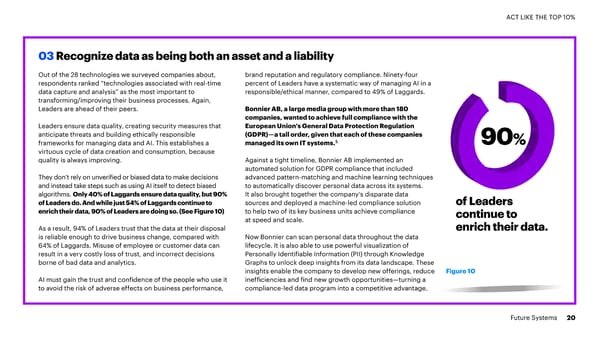
ACT LIKE THE TOP 10% 04 Manage technology investments well Leaders track returns on automation — across the enterprise Leaders have clear visibility into company-wide technology investments. 100 For example, 94% of them systematically track return on investments in automations across the organization, compared to only 47% of Laggards. (See Figure 11) 80 Leaders work toward business alignment – a key stepping stone for innovation transfer—by breaking down barriers between IT and other LEADERS departments. They also establish innovation centers, creating pipelines for innovation transfer. For example, they might consider how improvements 60 94% in machine-learning-driven sales and customer relationship technology could be used to predict and preempt employee turnover. A health insurance company, for instance, is using live dashboards 40 to track bots and automated activities running across their portfolio of businesses. The visibility allows them to calculate the benefits of LAGGARDS these investments in real-time—for example, by knowing that one bot saves 15 minutes of someone’s time every time it runs, which is 20 47% 200 times per week. The company can also identify new opportunities to expand their automation program. And perhaps the most intangible yet crucial benefit 0 of the dashboards is their power as a visualization tool to persuade non- believers, softening the resistance people have to any kind of culture Figure 11: 94% of Leaders systematically track return on change and paving the way for greater automation adoption. investments in automation across the organization, compared to only 47% of Laggards. Future Systems 21
ACT LIKE THE TOP 10% 05 Find creative ways to nurture talent Leaders understand that investing in talent is the best A large utilities company is currently exploring how way to advance Future Systems. As these systems 3D, Extended Reality and AI technologies can help evolve, so must the IT workforce. In fact, a workforce nuclear fleet operators to train their powerplant immersed in yesterday’s technologies is one of the personnel in any scenario, at any time. biggest obstacles to creating the expansive, flexible, human-centric systems necessary for success. With VR, they can design training scenarios and simulations that would otherwise be too inaccessible, 87% Our survey respondents believe that without some expensive or dangerous if carried out in the real world. This 90% retraining, 52% of their IT workforce’s skills and almost kind of simulation is also useful in emergency response half (47%) of their non-IT workforce’s skills will be planning in large, complex sites like shopping malls and obsolete in three years. theme parks. The human-like interaction with technology can make a notable impact, not just by training workers but Leaders are far outpacing Laggards in skills training: by making facilities safer for everyone. They use experiential learning at three times the rate of Laggards (73% versus 24%) and they launch Leaders also make sure their talent is not afraid to of Leaders use apprenticeship programs at more than double the rate of experiment and present non-traditional ideas— AI and advanced Laggards (79% to 36%). Eighty-seven percent of Leaders important components of learning and growing. Eighty- are using AI and advanced analytics to personalize four percent of Leaders have fostered a fail-fast culture, analytics to learning, predict skills needs and match workers’ skill for example, versus only 44% of Laggards. personalize requirements with appropriate training modules. Only 35% of Laggards use these techniques. learning. (See Figure 12) Figure 12 Future Systems 22
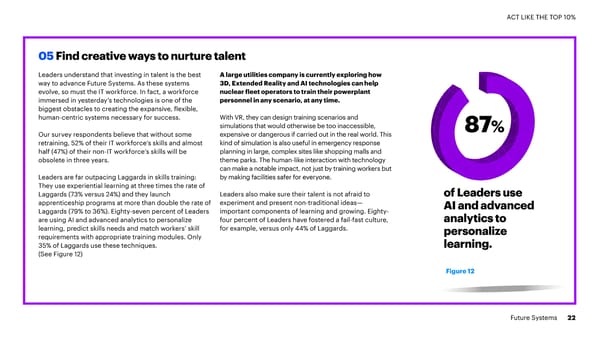
ACT LIKE THE TOP 10% Architecture is the biggest barrier to innovating at scale System Trust Organizational Transaction Costs Technology Adoption Architecture Flexibility 100% 90% s s 80% e n e iv t c 70% e f f E 60% 50% 0% Japan Spain Italy Brazil China India France Canada Australia Malaysia Thailand Singapore Germany Indonesia Philippines Switzerland Netherlands South Africa United States United Kingdom Figure 13: A cross the world, companies cite architecture flexibility as the biggest of four barriers to innovating at scale. Respondents were asked about their effectiveness in addressing each. Future Systems 23
OUR PLAN, YOUR MOVE Spending money on the latest technologies and working hard to solve problems as they arise is simply not enough to get to the top in today’s fiercely competitive business environment. Future Systems 24

This is a modal window.
OUR PLAN YOUR MOVE Though they might both possess knowledge, talent and ambition to spare, the distance between the Leaders and Laggards is huge: Leaders have twice the revenue growth of Laggards, who could miss out on up to 46% of their annual revenues by 2023 if they don’t change. To scale innovations repeatedly and grow twice as fast as others, companies have to depart from adopting technologies as point-solutions. Instead of a patchwork of technologies, they must evolve future systems by cultivating the mindset and methods of the top 10%, right now. Those that wait will find it increasingly difficult to catch up, as new technologies proliferate and the pace of innovation accelerates. Leaders already enjoying a considerable head start will not be standing still. The systems they have in place are specifically designed to not only accommodate innovations in technology, but also scale them across the enterprise. The race is not to arrive to some fixed endpoint in the future, but to build boundaryless, adaptable and radically human systems for the future. Future Systems 25
NOW IS THE TIME TO MAKE YOUR MOVE TO FUTURE SYSTEMS. HERE’S HOW: Boundaryless Adaptable Radically Human 1. Break through the cloud ceiling 1. S tage an architectural intervention 1. Master human-centric development Cloud isn’t the finish line—it’s the Let go of old ways of working Put humans at the center of starting point. to create architectures that can your design processes, recognizing constantly flex and adapt. that data and technology alone can’t 2. Design for disruption solve every problem. Insulate against change by leveraging 2. Identify the biggest friction flexible architectures and designing points in your business 2. Break down organizational interoperable systems. Technologies like AI, blockchain, and and cultural barriers microservices can help solve your biggest Scrutinize how organizational 3. Decouple the entire IT stack business challenges. or cultural boundaries may hinder Remove unnecessary dependencies speed and accountability. Embed an across all layers of the solution stack. 3. U nderstand the need for responsible AI end-to-end ownership culture from Adaptive systems must gain the trust and initial idea to user experience. 4. Explore new, unconventional confidence of the people they work with business models and for. 3. Don’t wait to experiment When boundaries disappear, with emerging technologies new partnerships open up to 4. Let data be your captain Experimenting early is the best way solve significant problems. Start with quality data and apply a data- to start socializing and imagining centric approach to your most important the commercial possibilities of business decisions. emerging technologies. Future Systems 26
ABOUT THE RESEARCH We employed a multi-method research approach for Future Systems. Specifically, the research program included surveys, interviews and case study research, and economic and machine learning modelling for diagnostics. 8356 Our research, and that of our partners in our companies, Company Size ecosystem, employs ethical and responsible global research methods. Respondents reveal their $500 million to identities voluntarily, we anonymize all data from 50% IT, $1.9 billion Over $25 billion 50% non-IT, $2 to $4.9 companies in our data set, and report results in billion $20 to $24.9 billion aggregate. We commit to not using the data C-level only $5 to $9.9 collected to personally identify the respondents Our dataset contains a range of Average Revenue growth: 6.4% billion and/or contact the respondents. companies from very high-growth (16%+) Average gross margin growth: 5.7% $15 to $19.9 billion to those witnessing declining revenue Average employee growth: 4.6% $10 to $14.9 1. Survey and margins, and many in between. billion The Accenture Future Systems Survey, 2019, is the largest survey of C-Suite executives on enterprise systems. The survey collected data on: 20 Industries 20 Countries (HQ) Financial Services Resources Products a. Technology adoption Banking (524) Utilities (515) Retail (351) Australia (538) Netherlands Spain (396) b. Application of technologies at scale across Capital Markets (515) Energy (Inc. Oil & Gas) Consumer Goods Brazil (388) (155) Switzerland organizational processes Insurance (515) (350) & Services (521) Canada (313) South Africa (209) c. Organizational and cultural readiness to adopt Communications Metals & Mining (350) Travel (350) China (1012) (155) UK (579) and create symbiotic systems of technologies Media & Technology Chemicals (350) Industrial France (395) Singapore (40) USA (2254) d. Multiple measures of financial and operational Media & Comms. (515) Health & Public Service Equipment (358) Germany (543) Thailand (61) performance Telecommunications (351) Health (356) Life Sciences (515) Italy (366) Malaysia (12) High Tech (350) Public Services (515) Automotive (352) India (246) Philippines (20) The graphic opposite summarizes Software & Platforms US Federal (353) Japan (631) Indonesia (43) the survey demographics. (350) Future Systems 27
ABOUT THE RESEARCH Inference Approach 2. Interviews and Multiple Case Studies First, we define and group companies into Future System We triangulate our findings from the large-scale primary Leaders and Laggards. That is, we identify companies that data from the survey with multiple case studies. Overall, we are ahead in terms of their evolution to Future Systems collected through secondary research and interviews about and those that aren’t, or, are evolving slowly. We then 30 case studies focusing on issues organizations are facing investigate if Future Systems leadership is correlated to because of their current IT stack and the evolution of financial performance. companies toward Future Systems. Definition of Leaders and Laggards: We create a Future Systems Score, composed 3.Economic Modelling and of three components: 1. Technology adoption. 2. Machine Learning Extent of technology adoption across organizational We use economic and machine learning (decision tree) processes, and 3. Organizational and cultural The regression below summarizes our (simplified) readiness for technology adoption. models for arriving at prescriptive insights. We used an modelling approach: ordered logit model to study if the adoption of specific The top 10% of the companies on this score we called technologies and their application to specific processes Future Systems Leaders, or simply Leaders and the bottom can increase the probability of higher revenue and growth Revenue= α + β *technologies adopted + β *processes 1 2 25% (Future System) Laggards. The rest of the 65% rates. In addition, to understand the cultural factors of transformed + β *technology*process + β *control 3 4 of companies in our sample sit somewhere between importance, we ran a machine learning based decision tree variables +μ Leaders and Laggards. classifier and explored correlations between Leaders’ Where, β - β are the key coefficients of interest and μ Calculation of the Performance difference Future Systems score with aggregate indices for the 1 3 company’s technology adoption and process is the error term of the regression Using the definitions above of Leaders and Laggards, transformation indices. we compare their financial performance—measured by average revenue growth—and calculate the difference in performance between Leaders and Laggards. To ensure that the results were robust, we calculate the difference in performance—the performance gap—in every industry. The results are robust throughout. Future Systems 28
A C R K EF N ER O EN W L C ED ES G EM EN T S The aut hors w ould lik e t o t hank Prashan t Shukla, PhD , t 1. h he ttps : / / www .apqc . o r g / pcf R esear ch Lead f or F ut ur e Syst ems, as w ell as Sury a ( 13 cr it ical business pr ocesses as defined b y APQC ) Mukher jee and Da vid La vier i fr om Accen t ur e R esear ch f or t hei r con t r i bu t i ons t o t h is r 2. h eport. ttps : / / www . t echno l og y r e v i e w . co m / s / 60 8 1 0 3 / an t - fi nanc i a l -ch i nas-g i an t -o f -m o b i l e-pa y m en ts- i s-r e th i n k i n g - fi n a n ce- w i th- a i / 3. h ttps : / / r ct o m. hbs. o r g / su bm issi o n / an t - financ ial-pi oneer ing-china- fin t ech- w i th- machine-lear ning / 4. h ttps : / / www . busi ness w i r e . co m / ne w s / ho me / 20 1806 190065 1 4 / en / A n t -F i nanc i a l - Share-F ull-Suit e- A I-Capabilities 5. h tt ps : / / www .a ccen t u r e . co m / i n-en / case- s t ud i es / t echno l og y / su ccess-bo nn i er -gd pr - co mpl i ance- a u t o ma t i o n Future Systems 29
About Accenture About Accenture Research Accenture is a leading global professional services Accenture Research shapes trends and creates data company, providing a broad range of services and driven insights about the most pressing issues global solutions in strategy, consulting, digital, technology and organizations face. Combining the power of innovative operations. Combining unmatched experience and research techniques with a deep understanding of our specialized skills across more than 40 industries and all clients’ industries, our team of 300 researchers and business functions—underpinned by the world’s largest analysts spans 20 countries and publishes hundreds of delivery network—Accenture works at the intersection of reports, articles and points of view every year. Our business and technology to help clients improve their thought-provoking research—supported by proprietary performance and create sustainable value for their data and partnerships with leading organizations, such stakeholders. With 492,000 people serving clients in as MIT and Harvard—guides our innovations and allows more than 120 countries, Accenture drives innovation to us to transform theories and fresh ideas into real-world improve the way the world works and lives. solutions for our clients. For more information, visit Visit us at www.accenture.com www.accenture.com/research Copyright © 2019 Accenture. All rights reserved. Accenture and its logo are registered trademarks of Accenture.

